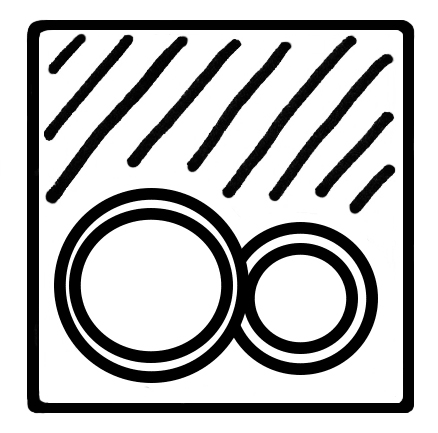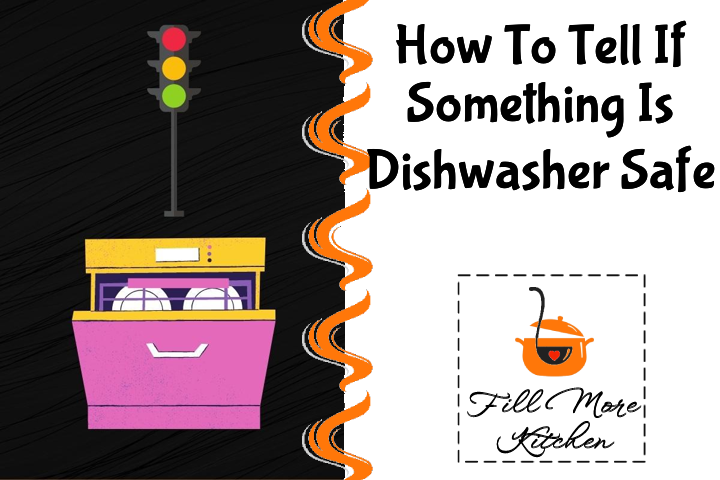The dishwasher is perhaps the most convenient device in the kitchen, saving time and effort that would otherwise be spent cleaning up after a meal. It can be challenging to find the motivation to wash dishes when you’re full and satisfied.
Identifying which items are safe to put in the dishwasher can be challenging as some may get damaged or broken during the cycle.
If you want to determine whether an item is suitable for washing in a dishwasher, examine its base for an etched or printed emblem that depicts a plate or glass with water droplets above it, while the label should state “dishwasher safe”; handles of pots and pans may have the symbol engraved on them.
Another step you can take is becoming acquainted with the categories of kitchenware that are not suitable for dishwasher cleaning.
If there is no label to indicate whether something is dishwasher safe or not, you can use your understanding of materials that are safe to wash in a dishwasher and proceed carefully.
If you find the concept too general, there’s no need to fret as we have more detailed information on how to guarantee that your dishes remain unharmed while attempting to save time washing them.
By the conclusion of this article, you should have a good understanding of what actions to take and avoid when loading your dishwasher.
How Can I Make Sure That an Item Is Dishwasher Safe?
One simple method to determine if an item is suitable for washing in a dishwasher is to verify whether it has a symbol engraved or imprinted on a tag.
The symbol indicating that an item is safe to be washed in a dishwasher may come in different designs, but typically features an illustration of plates or glasses with lines or water droplets above or around them.
If you are aware that the item is made of a material that can be cleaned in a dishwasher, and the dishwasher-safe symbol is not visible on it, you can still opt to clean it in the dishwasher.
In case you are unaware of the material of an item and it does not have a symbol indicating that it is safe for dishwashers, it would be advisable to wash it manually to avoid any unintended harm to the object or your dishwasher.
What Happens If I Put an Item That Isn’t Dishwasher-safe In the Dishwasher?
Putting a non-dishwasher-safe item in the dishwasher can often result in damaging the item.
Dishwasher safe is not applicable for items such as wood, fragile glass, or delicate china with painted designs because the high temperature, moisture, and water pressure can cause them to break, deform their surfaces, or remove their patterns.
Including items that are not dishwasher-safe in a wash cycle can result in harm to the dishwasher in certain situations.
If something is covered in machine grease, paint, or dirt, it should not be put in the dishwasher as it could cause clogging due to anything other than light food grime.
Dishwasher safe items are those that can withstand high heat and water pressure without getting damaged, so it’s important to avoid putting in things like light plastics or jar labels that could melt or un-stick during the cycle and potentially harm your dishwasher.
What Makes Something Not Dishwasher-Safe?
Items are typically deemed suitable for use in a dishwasher if they can consistently withstand high temperatures, intense water pressure, and detergent exposure without experiencing any harm.
Any kitchen utensil or equipment that has a high probability of getting damaged due to one or more of these factors would not be deemed suitable for dishwasher use and should be washed by hand instead.
Cast iron cookware is not suitable for dishwasher use as it has a higher risk of developing rust or losing its seasoning compared to other types of metals.
Similarly, it is advisable to refrain from putting non-stick cookware in the dishwasher as the high-heat cycles may cause damage to the non-stick coating.
Wood is not suitable for dishwasher use as the high levels of heat and humidity during a cycle can cause it to become damaged, leading to potential cracking or warping.
Dishwasher safe items should be prioritized over delicate glassware like crystal, which can easily break, chip, or develop damaging blemishes on its surface if subjected to the harsh conditions of a dishwasher; therefore, it is recommended to hand-wash such items with care.
What’s the Difference Between Dishwasher-Safe and Dishwasher-Proof?
Anything that can withstand a dishwasher cycle can be referred to as “dishwasher-proof,” but this does not ensure that the item will remain in its original state. The term only implies that the item is unlikely to break beyond repair or harm the dishwasher.
Kitchenware that is safe to be washed in a dishwasher may experience alterations such as surface peeling or warping.
Basically, these are impairments that may not affect the usability of the object but will cause some form of change, particularly when it is repeatedly washed in a dishwasher.
An item labeled as “dishwasher-safe” can endure the harsh conditions of a dishwasher cycle and will maintain its initial form, including its visual appeal and practicality, even after multiple washes.
Does the Dishwasher-Safe Symbol Always Look the Same?
While there is no universally accepted symbol for indicating that an item is safe to be washed in a dishwasher, there is a common standard for what the symbol should contain.
The primary classifications of these symbols include those that signify an object is typically suitable for dishwashing or only safe for use on the top rack of a dishwasher.
The most frequently used design for a symbol indicating that an item is safe to be washed in a dishwasher is represented by plates or glasses with water droplets or dotted lines. On the other hand, the symbol indicating that an item can only be washed on the top rack of a dishwasher usually consists of two plates with solid lines in the background.
For an item to be deemed dishwasher safe, it should have a symbol resembling this on its surface:

Popular Questions Regarding Dishwasher-Safe Items
Given all the preceding information, here are some particular objects that individuals frequently question whether they can place in their dishwasher.
What Plastics Are Dishwasher-Safe?
During a dishwasher cycle, certain plastics may release harmful chemicals or become unusable due to the hot water and intense pressure, which can also damage the dishwasher.
Polypropylene and low or high-impact polyethylene are commonly used to make food storage containers, and all three of these materials are deemed suitable for dishwashers when placed on the top rack.
Nevertheless, these plastics are still susceptible to harm caused by repeated use in the dishwasher.
To determine if plastic is safe to put in the dishwasher, it is important to look for a dishwasher safe symbol. Failure to do so may result in the activation of harmful chemicals during the cycle, which can pose a risk to your health.
Are Ziploc Containers Dishwasher-Safe?
The Ziploc containers are free from BPA and are deemed dishwasher-safe by the brand, meaning they can withstand the dishwasher’s cleaning process without any harm.
It is important to note that chemicals can seep out of all types of plastic, including those labeled as BPA-free, therefore it is advisable to wash plastic containers manually rather than using the dishwasher.
Are Non-Stick Pans Dishwasher-Safe?
Non-stick pans are a convenient type of kitchen utensil that requires appropriate maintenance to preserve its complete efficiency.
Putting your pans in the dishwasher can be one of the ways to damage and wear down their non-stick coating.
Handwashing your non-stick cookware is recommended to prevent the deterioration of the coating caused by the high heat and pressure of a dishwasher cycle, which can render them useless over time and require frequent replacement.
Are Baby Bottles Dishwasher-Safe?
Generally, baby bottles made of glass are safe to put in the dishwasher, but it’s important to note that the detergent used for regular dishes may not be appropriate for baby items.
Using a mild, unscented dishwashing liquid is advised for washing any infant feeding gear. If you possess an eco-friendly dishwasher soap, it is safe to include baby bottles in the wash cycle.
Is Porcelain Dishwasher-Safe?
Porcelain is a fragile kind of tableware that is frequently hand-decorated, and the most straightforward approach to maintain its delicate appearance is by washing it manually. However, it should be noted that the majority of porcelain produced after 1979 can be safely washed in a dishwasher.
If you want to confirm that your china can be safely washed in a dishwasher, make sure to look for a symbol indicating that it is dishwasher-safe on the label. In case there is no symbol available, check for the manufacturer’s name as many well-known porcelain brands are certified to be safe for dishwashers.
If you don’t have access to information about the origin and age of your china, it’s best to hand-wash it instead of taking the risk of damaging it during a dishwasher cycle.
Similarly, porcelain items that have metallic embellishments should not be washed in the dishwasher as the embellishments may deteriorate.
Is Tupperware Dishwasher-Safe?
Just like Ziploc containers, the majority of Tupperware containers are safe to be washed in a dishwasher as they are constructed from durable plastics. However, if you possess Tupperware items that were manufactured prior to 1979, they should not be put in a dishwasher.
Are Take-out Containers Dishwasher-Safe?
Takeout containers are typically composed of the same plastics mentioned earlier, making them safe to reuse and clean in a dishwasher for a maximum of six months.
Nevertheless, the same warning about using plastics in high temperatures applies to them.
If the material of a container is unknown and there is no indication of it being dishwasher-safe, it is recommended to opt for handwashing to prevent any potential hazards.
You can also check this video about “How To Tell If Something Is Dishwasher Safe”
Check out our 10 reviews!
Related posts
https://fillmorekitchen.com/first-things-to-check-when-a-refrigerator-stops-working/
https://fillmorekitchen.com/what-to-do-if-you-accidentally-put-laundry-detergent-in-the-dishwasher/
https://fillmorekitchen.com/can-you-eat-kebab-left-out-overnight/
https://fillmorekitchen.com/is-a-mini-fridge-worth-it/
https://fillmorekitchen.com/can-you-eat-mac-and-cheese-left-out-overnight/



